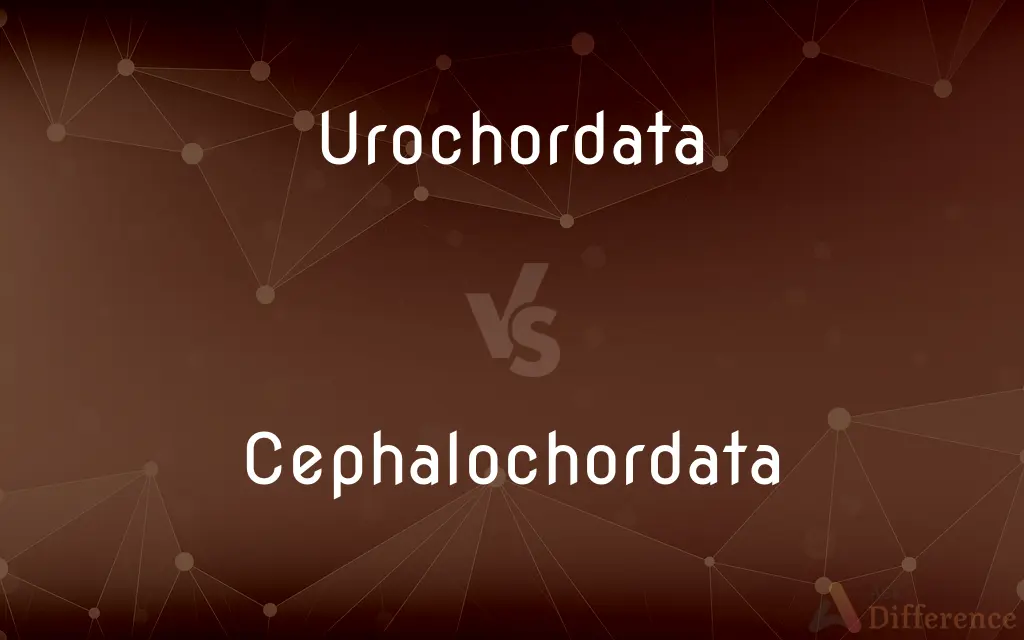Urochordata vs. Cephalochordata — What's the Difference?
By Tayyaba Rehman — Updated on September 23, 2023
Urochordata are marine invertebrates with a tunic covering; Cephalochordata are small, fish-like animals with notochords running their full body length.

Difference Between Urochordata and Cephalochordata
Table of Contents
ADVERTISEMENT
Key Differences
Urochordata and Cephalochordata are both subphyla within the phylum Chordata. Urochordata, commonly known as tunicates, are marine invertebrates that often have a tough outer "tunic." This tunic is primarily composed of cellulose, a rare instance of this compound in the animal kingdom. Cephalochordata, on the other hand, are represented by lancelets, which possess a notochord that extends throughout their body.
Members of Urochordata are diverse in form, including sessile ascidians and free-swimming forms like salps. Interestingly, only their larval stage displays chordate characteristics like the notochord and tail. In contrast, Cephalochordata, throughout their life, retain these chordate characteristics, including the dorsal nerve cord and notochord.
The notochord in Urochordata is present only in the larval stage and degenerates as the organism matures. This is in stark contrast to Cephalochordata, where the notochord persists throughout the animal's life, lending support to its body and aiding in locomotion.
A significant difference between Urochordata and Cephalochordata lies in their evolutionary significance. While Urochordata provides insights into the evolution of vertebrates, particularly the transition from invertebrates to vertebrates, Cephalochordata represents a critical evolutionary bridge, showing primitive chordate features still present in modern-day lancelets.
Comparison Chart
Common Names
Tunicates
Lancelets
ADVERTISEMENT
Notochord Presence
In larval stage only
Throughout life
Body Covering
Tough outer "tunic"
No outer tunic
Habitat
Marine environments
Mostly marine environments
Evolutionary Role
Transition from invertebrates to vertebrates
Represents primitive chordate features
Compare with Definitions
Urochordata
Commonly known as tunicates.
The diverse forms of Urochordata include both sessile and free-swimming organisms.
Cephalochordata
Possess a notochord that extends throughout their body.
The notochord in Cephalochordata provides support and aids in locomotion.
Urochordata
Characterized by a tough outer "tunic."
The protective tunic in Urochordata is primarily composed of cellulose.
Cephalochordata
Retain chordate characteristics throughout life.
Unlike Urochordata, Cephalochordata consistently display their notochord and dorsal nerve cord.
Urochordata
Displays chordate characteristics only in the larval stage.
As the Urochordata larva matures, its notochord degenerates.
Cephalochordata
Commonly referred to as lancelets.
Cephalochordata are often studied to understand primitive chordate features.
Urochordata
Play a role in understanding vertebrate evolution.
Studying Urochordata can provide insights into early vertebrate development.
Cephalochordata
Important for studying the evolutionary history of chordates.
Cephalochordata offer a glimpse into the early features of the chordate lineage.
Urochordata
Marine invertebrates under the phylum Chordata.
Sea squirts belong to Urochordata because of their tunic-covered bodies.
Cephalochordata
Small, fish-like animals belonging to the phylum Chordata.
Lancelets, found in marine environments, are a prime example of Cephalochordata.
Urochordata
Tunicates
Cephalochordata
Lancelets
Common Curiosities
Do Cephalochordata have a tunic like Urochordata?
No, Cephalochordata do not have an outer tunic.
Do Urochordata retain their notochord throughout life?
No, Urochordata only have a notochord in their larval stage.
What is the significance of the notochord in Cephalochordata?
It provides support to the body and aids in locomotion.
What is the common name for Cephalochordata?
They are commonly referred to as lancelets.
How does the habitat of Cephalochordata compare to Urochordata?
Both primarily inhabit marine environments.
Where can members of Urochordata be found?
They are primarily found in marine environments.
What are Urochordata commonly known as?
Urochordata are commonly known as tunicates.
Why are Urochordata significant in evolutionary studies?
They provide insights into the transition from invertebrates to vertebrates.
Do Cephalochordata and Urochordata belong to the same phylum?
Yes, both belong to the phylum Chordata.
Do Cephalochordata play a role in understanding chordate evolution?
Yes, studying Cephalochordata provides insights into the early features of chordates.
Are Cephalochordata invertebrates?
Yes, like Urochordata, they are invertebrates.
Which subphylum represents primitive chordate features?
Cephalochordata represents these early chordate features.
How do Urochordata and Cephalochordata differ in form?
Urochordata are diverse, from sessile to free-swimming, while Cephalochordata are small and fish-like.
Which subphylum retains chordate features throughout life?
Cephalochordata retain chordate features throughout their lifespan.
What is the primary composition of the tunic in Urochordata?
It is primarily composed of cellulose.
Share Your Discovery

Previous Comparison
Distributor vs. Retailer
Next Comparison
Garment vs. ClothesAuthor Spotlight
Written by
Tayyaba RehmanTayyaba Rehman is a distinguished writer, currently serving as a primary contributor to askdifference.com. As a researcher in semantics and etymology, Tayyaba's passion for the complexity of languages and their distinctions has found a perfect home on the platform. Tayyaba delves into the intricacies of language, distinguishing between commonly confused words and phrases, thereby providing clarity for readers worldwide.
















































